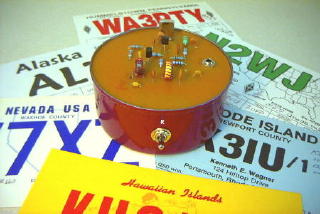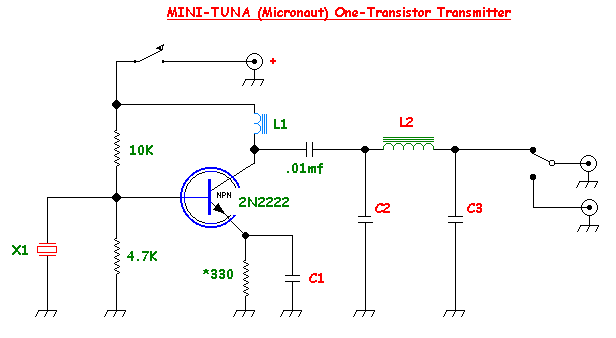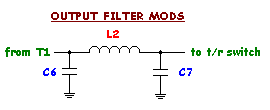


In May 1976, QST printed an article that would become legendary! "THE TUNA TIN II" by Doug Demaw (W1CER) was an instant hit. Doug's original article, which can be read on the ARRL's members page, described a simple two-transistor QRP transmitter for 40m CW that could be built with readily available Radio Shack components and of course, an empty tuna can! Over the next few months and years, hundreds of Tuna Tin II's were built and put into operation and many hams were introduced to the challenge of QRP for the first time. Eventually, Tuna Tins' were retired to dusty shelves or fleamarkets as QRPers and builders moved onto newer challenges. In the late '90's, Doug's original Tuna Tin was spotted by sharp-eyed ARRL Techi, Ed Hare (W1RFI), in just one such fleamarket in Boxboro, Massachusetts. After refurbishing by Bruce, W6TOY (SK) it was returned to active duty by Ed and the "Tuna Tin II Revival" was under way!REVIVAL - In mid 2000, I too became swept up in the second Tuna Tin revolution and purchased a Tuna Tin kit from the Norcal QRP club. It turned out to be the best $13 I had ever spent. After carefully putting the kit together, early one July morning I put out my first 250mW CQ on the 7.040 40m QRP calling frequency. I really didn't have high hopes but I was immediately answered by KJ7AN in Dallas, Oregon who gave me a 579 report! Over the next three days I worked several more stations in Oregon, Washington, Idaho and even California. I was very delighted with the little rig but assumed that my little signal would probably not go much farther than the closer western states and maybe, if I was very lucky, a few more Californians.
All that changed early on the morning of August 6th! About an hour after sunrise, my tentative hand-keyed "CQ" was answered by Steve, NØTU in Colorado!! Steve had been enjoying his morning coffee while the quiet hiss of 7.040 in the background was broken with my very weak call. We had a good solid QSO and after it was over, I realized that the little Tin had a lot more potential than I had realized. It seemed to me that if my little signal could skip all the way to Colorado in August, then it should go a LOT farther during the winter DX season....perhaps far enough to work all fifty states? It was at that point that I decided to give it a try.The first thing I did was to make my 40m half-sloper as efficient as possible. The length was trimmed and the angle adjusted until the SWR was almost negligible. I then began burying radials around the perimeter of the tower. I ended up with around 35 in total. Although the SWR on the antenna did not change, the bandwidth of the antenna narrowed, indicating an improved Q and hopefully a more efficient radiator.
When the fall DX season approached, I watched 7.040 every weekend and the new states soon began piling up. In early December I worked WG7Y in Wyoming for state #50 to claim the first Tuna Tin "Worked All States". Unfortunately the ARRL does not have any special endorsements for Tuna Tins but they did stamp it with the "QRP" symbol!OPERATING TIPS - The first thing you need to do is make sure that you have an efficient antenna system! If you have a vertical then lay down as many radials as you can. If you are using a wire antenna like a dipole or G5RV then get it as high as possible. Be sure the SWR is low so that the transfer of power from the Tuna Tin's output circuit (50 ohms) is as efficient as possible or use a tuner to match the load. Any mismatch will result in power loss and at this power level you can't afford to throw it away. The final amplifier (2N2222) should not get hot; it should not even get warm! You want to heat up the antenna, not the transistor!
Call CQ or other stations near your frequency with confidence. Just because they are weak doesn't mean they may not hear you; maybe they are running QRP or even a Tuna Tin as well! When working another station, stick to the essentials...RST...name...QTH. Keep transmissions short as QSB will often take out your weak signal a lot faster than it will a 5W one.
MODS - One of the easiest mods to make is to change the final amplifier's emitter resistor (R7) from 56 ohms to 12 ohms.
This allows the final to draw more current which will probably give you at least another 100-150mW output power or about 3db more ooomph.
Although not really a mod, this next little circuit will allow you to use your electronic keyer with the Tuna Tin. If you have a programmable message keyer, it can make life a lot easier when calling CQ...over and over. Of course true Tuna Tin devotees would argue that a hand-key is the only thing to use with a Tuna Tin and anything more is true sacrilege! I built this circuit into a small 35mm film canister and simply plug it in between the keyer and the tin. The use of the keyer is very handy, especially when contesting.
THE MINI-TUNA (Micronaut)
Here is my newest QRP radio! I believe this circuit was first developed by Dave Ingram, K4TWJ, and has been published many times over the years as the "Micronaut". I prefer to call my version the "MINI-TUNA" since it is built into a small cat-food tin! It consists of a single 2N2222 crystal oscillator and runs about 100mw output, depending on the supplied voltage. Voltage can range from 2 volts to as high as 18 volts. This particular one was built for 20m and works well. As of March 2007, 33 states have been worked with the 'micronaut'. "W.A.S." should be possible with this delightful little handful of parts!
The circuit is pretty simple. Antenna switching is done right at the transmitter, just like the Tuna Tin. Here is everything you should need to build the circuit:

The emitter resistor (*330 ohms) can be varied to increase or decrease output levels. I ended up with around 270 ohms. Going too low in value will cause excessive heating or transistor failure. L1 is a small RF choke made by winding three or four turns of #32 wire on a small ferrite bead.
If you want to try different bands, here is the information required:
THE 20m TUNA TIN
After completing W.A.S. with the 40m Tin, I decided to scratch-build a 20m model. Very few changes are needed and those are mainly with the output filter. You will of course require a fundamental crystal for 20m. I have two - one for the QRP frequency (14.060) and one down in the DX portion of the band (14.030). The little 20m Tin has been a blast with a total of 46 states and 21 countries so far. Some of the more interesting contacts are shown here. Being able to use a 3el tribander (Cushcraft A3S) with the Tin is a big advantage and the rig has received several 589 and 599 reports from Europe.

Here are the details for the filter changes in the original 40m circuit:Change both C6 and C7 to 220pf; L2 is 12 turns of #22 on a T-50-6 toroid core. Certainly a three or four stage filter would result in a smaller harmonic content but ...hey...it's a Tuna Tin and I don't think your harmonics are really going to cause too much QRM. (Besides, when 10m is open you can work real QRP DX on your second harmonic!) Also, for 20m, change C2 (beside the crystal) from 100pf to 47pf.
Now that you are itching to get started, here are links to everything you will ever want or need to know about Tuna Tin building.
TUNA TIN LINKS
QST's Original Tuna Tin 2 Article - Demaw's 1976 article
Tuna Tin Gallery - Four pages of homebrew Tins!

